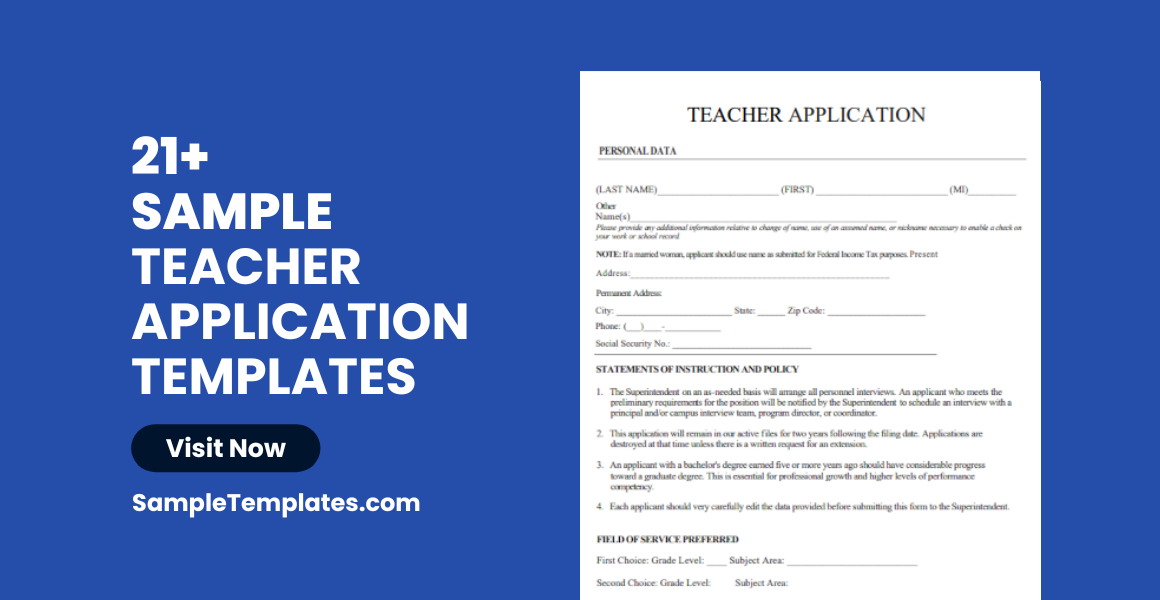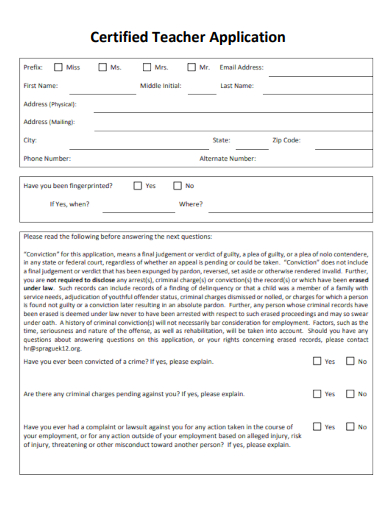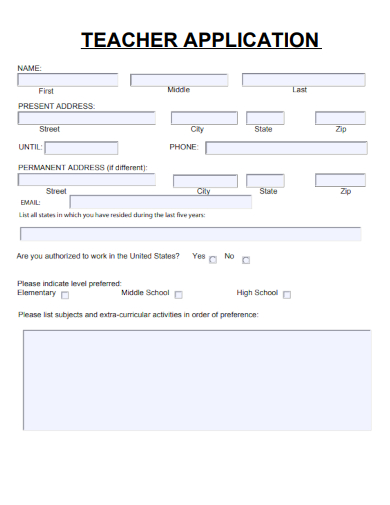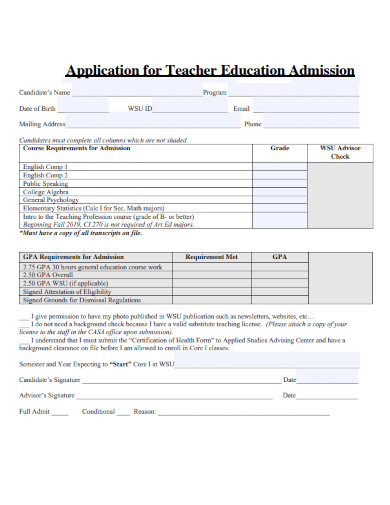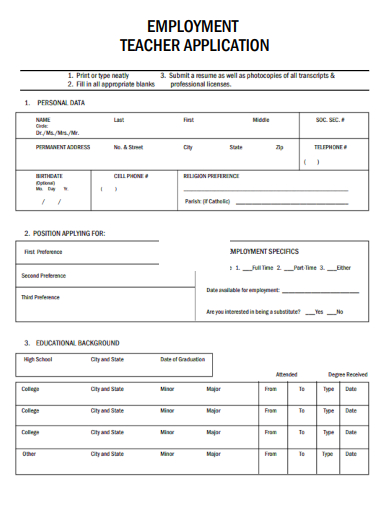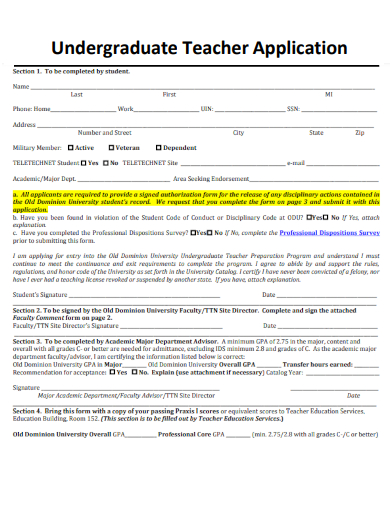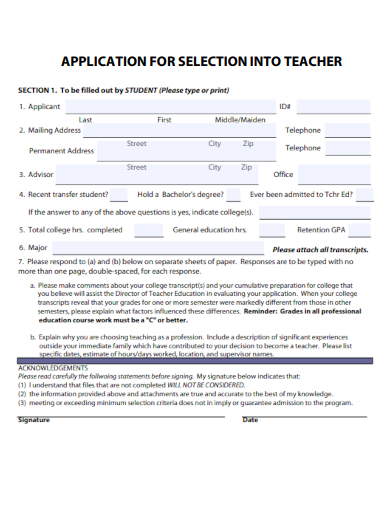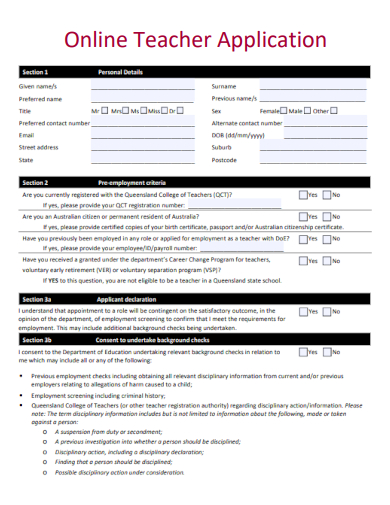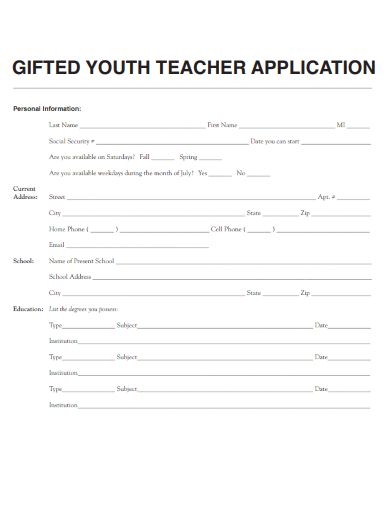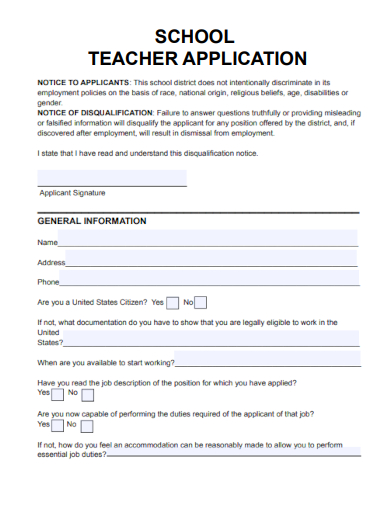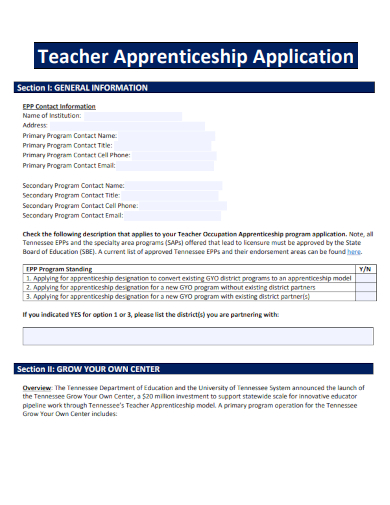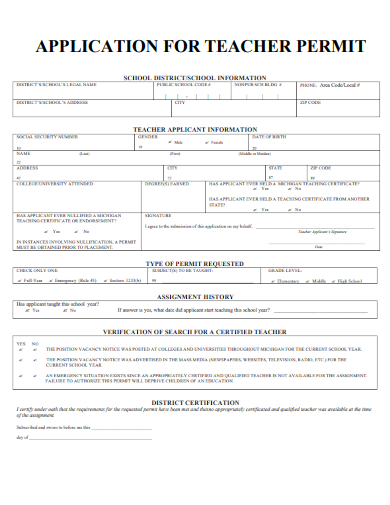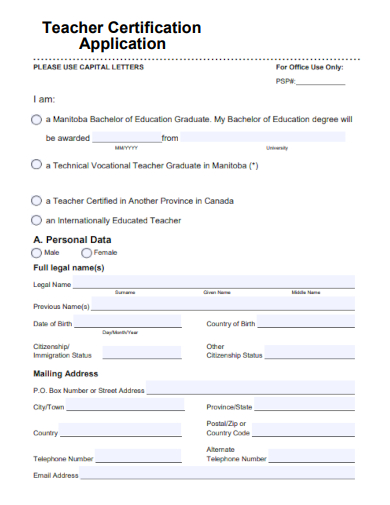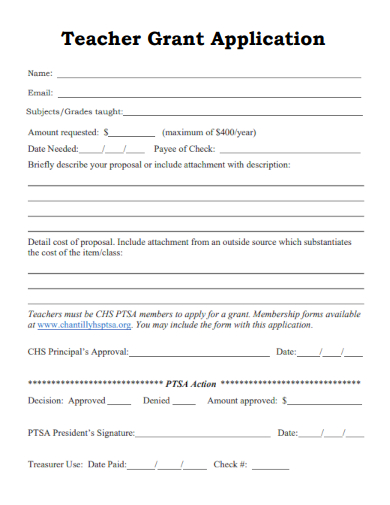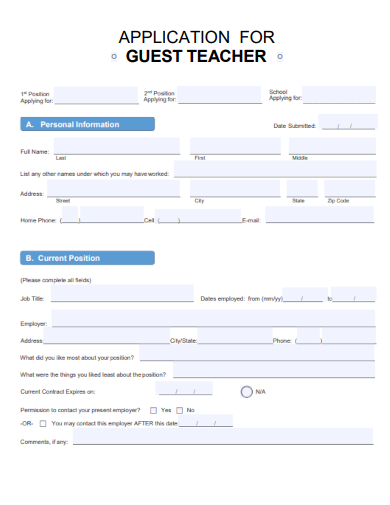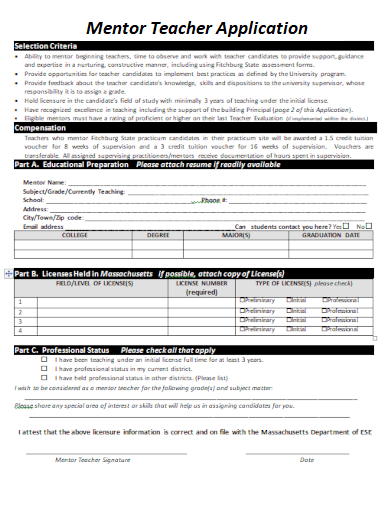In the educational arena, the ‘Teacher Application’ is a gateway to transformative classrooms. It’s more than just a sample form; it’s a reflection of an educator’s passion, expertise, and commitment to the craft. Schools and institutions rely on these applications to bring aboard educators who resonate with their vision. Dive deep into our guide, uncovering the intricacies, best practices, and the profound impact a well-curated Teacher Application has on the academic community.
FREE 21+ Teacher Application Samples
1. Sample Application Letter for Teacher Template
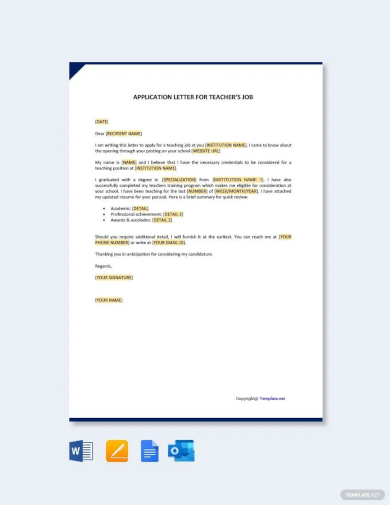
2. Sample Job Application Letter for Teacher Job
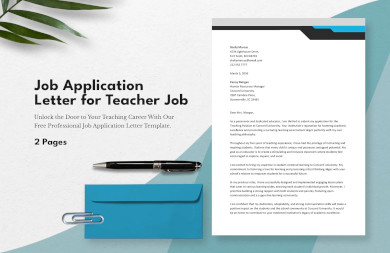
3. Sample Teacher Application Cover Letter Template
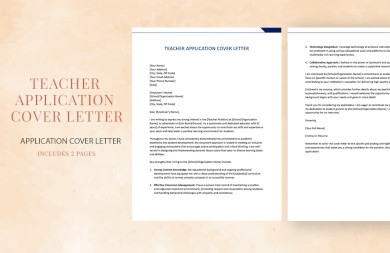
4. Sample Teacher Application Template
5. Sample Teacher Registration Application Template
6. Sample Certified Teacher Application Template
What is Teacher Application?
The term “Teacher Application” can evoke different ideas depending on the context. In many scenarios, when we talk about a “Teacher Application,” we are referring to a design document that educators fill out to apply for a teaching position in an educational institution. This application typically captures an educator’s qualifications, experiences, and intent, offering a snapshot of their professional journey and aspirations.
Components of a Teacher Application
- Personal Details: This section includes the applicant’s name, contact information, and often, a professional photograph.
- Objective Statement: A brief sample statement highlighting the applicant’s teaching goals and aspirations.
- Educational Background: Detailed information about the applicant’s academic qualifications, including degrees, institutions, and years of completion.
- Teaching Experience: A chronology of teaching positions held, including the names of institutions, durations, and key responsibilities.
- Certifications: Information about any teaching licenses, sample certifications, or specialized training courses completed.
- Skills and Competencies: Highlighting abilities like classroom sample management, curriculum development, and any other pertinent skills.
- References: Details of professionals who can vouch for the applicant’s capabilities and character.
The Importance of the Teacher Application
- First Impression: In many cases, the Teacher Application is the first point of contact between an educator and a potential employer, making it crucial to leave a positive impression.
- Showcase of Qualifications: It’s an organized way to display academic achievements, teaching experiences, and other credentials.
- Reflection of Commitment: The effort and detail put into the application can reflect an applicant’s dedication and commitment to the profession.
Tips for Crafting a Winning Teacher Application
- Stay Relevant: Ensure all the information included is relevant to the position being applied for.
- Be Concise: While being thorough is essential, it’s equally important to be concise and avoid unnecessary details.
- Proofread: Grammatical errors or typos can leave a negative impression. Always proofread the application multiple times.
- Highlight Achievements: Instead of just listing responsibilities in previous roles, highlight specific achievements or impacts made.
- Personalize Each Application: Tailor the application for each position, making sure to address the specific needs or requirements of the institution.
Common Mistakes to Avoid
- Being Generic: Schools receive numerous applications. Standing out requires a touch of personalization and genuine passion.
- Overloading Information: While it’s tempting to include every minor achievement, it’s vital to prioritize and include only significant accomplishments.
- Neglecting the Cover Letter: Often accompanying the Teacher Application, a sample cover letter is an opportunity to further express one’s passion and suitability for the role. Never underestimate its importance.
The Digital Age and Teacher Applications
With advancements in technology, many institutions now prefer digital applications. This shift has added components like:
- Video Introductions: Some schools ask for short video clips where applicants introduce themselves, offering a more personal touch.
- Digital Portfolios: Including links to online sample portfolios showcasing lesson plans, student projects, or other teaching materials.
Implementation of the Teacher Application:
The implementation of a Teacher Application system, whether it’s a digital platform or a paper-based process, requires strategic planning, proper resources, and coordination among different stakeholders. The goal is to create an efficient, user-friendly system that streamlines the hiring process for educational institutions and provides applicants with a clear pathway to submit their credentials. Here’s a comprehensive guide on how the Teacher Application system is typically implemented:
1. Needs Assessment and Planning
- Identify Objectives: Before diving into implementation, it’s crucial to understand the goals. Are you transitioning from a paper-based system to digital? Are you aiming for broader outreach or more streamlined internal processing?
- Stakeholder Consultation: Engage with key stakeholders, including hiring managers, school administrators, IT teams (for digital systems), and even potential applicants for a sample feedback on the desired features and potential challenges.
2. Design and Development
- Choose a Platform: For digital systems, decide if you’ll use an off-the-shelf software solution or develop a custom platform. Each has its pros and cons concerning flexibility, cost, and scalability.
- Form Design: Ensure the application form captures all necessary information, including personal details, educational qualifications, experience, certifications, and references. The design should be user-friendly and intuitive.
- Integration with Other Systems: If digital, the application system might need to integrate with HR software, email systems, or databases where applicant data is stored and processed.
3. Testing Phase
- Pilot Testing: Before full-scale implementation, conduct a pilot test. This involves releasing the application system to a smaller group, ensuring all features work as intended.
- Feedback Collection: After the test, gather feedback. Look for any glitches, bottlenecks, or user experience issues.
- Refinement: Based on feedback, make necessary adjustments to the system.
4. Full-scale Rollout
- Training: If it’s a new system, especially digital, ensure that all relevant staff members are trained on its use. This includes how to access applications, how to process them, and how to troubleshoot common issues.
- Launch: Announce the launch of the new application system through appropriate channels. This might include the institution’s website, email newsletters, or physical posters and flyers for a traditional system.
5. Ongoing Management and Monitoring
- Regular Updates: Ensure that the system remains updated, especially if it’s digital. This involves periodic software updates, security patches, and any necessary tweaks based on user feedback.
- Performance Monitoring: Track key metrics like the number of applications received, processing times, and any system errors or issues.
- Feedback Loop: Maintain an ongoing feedback mechanism where users (applicants and staff) can report issues or provide suggestions for improvement.
6. Periodic Review
- Annual or Biannual Review: Periodically assess the system’s effectiveness. Are you attracting the right candidates? Is the process efficient? Are there any recurring issues?
- Evolution with Time: As technological advancements occur or institutional needs change, the application system should adapt. This might involve adding new features, removing obsolete ones, or even overhauling the system if required.
How to Fill a Teacher Application?
Filling out a Teacher Application is a critical step for educators seeking positions in schools, colleges, or other educational institutions. The application not only showcases your qualifications and experiences but also serves as your first impression to potential employers. Here’s a step-by-step guide on how to fill out a Teacher Application:
1. Gather Necessary Documents
Before you begin, make sure you have all required documentation on hand:
- Academic transcripts
- Teaching certifications or licenses
- Professional references or recommendation letters
- Sample Resume or CV
- Any other required materials, like a teaching philosophy statement, portfolio, or identification documents
2. Read Instructions Carefully
Most applications come with specific instructions. Read them thoroughly to ensure you understand what is expected and how you should proceed.
3. Personal Information
- Fill in your full name, ensuring it matches with official documents.
- Provide current address, phone number, and professional email address.
- Some applications might ask for additional details, like date of birth, nationality, or gender.
4. Educational Background
- List your academic qualifications, starting from the most recent.
- Include the degree title, institution name, graduation date, and any honors or awards.
- If transcripts are required, know the procedure – whether they’re to be attached, sent separately, or submitted upon request.
5. Professional Experience
- List your teaching experiences in reverse chronological order.
- Include the position title, institution, start and end dates, and key responsibilities.
- If you’re a new teacher with limited experience, consider including student-teaching, tutoring, or any related roles.
6. Certifications and Licenses
- Detail any teaching licenses or certifications you hold.
- Include the certifying body, certification date, and expiration date (if applicable).
- Some applications might require a copy or official verification, so be prepared.
7. Teaching Philosophy or Objective (if required)
- Briefly describe your teaching beliefs, methods, and goals.
- Keep it concise, relevant, and authentic. Remember, this is a chance to showcase your passion and approach to teaching.
8. Skills and Competencies
- List relevant skills – like classroom management, curriculum development, technological proficiency, or any language proficiencies.
- Avoid being generic; focus on skills that set you apart and align with the position you’re applying for.
9. References
- Typically, applications ask for 2-3 professional references.
- Include the reference’s name, title, institution, phone number, and email.
- Always inform your references in advance that you’re listing them. Ensure they’re comfortable vouching for you.
10. Additional Materials
- Some applications might ask for portfolios, lesson sample plans, or sample teaching videos. Ensure these are well-organized and reflect your best work.
- If digital submissions are required, ensure files are appropriately named, formatted, and are of a manageable size.
11. Review and Proofread
- Before submitting, review your application multiple times.
- Check for any typos, grammatical errors, or omissions.
- Consider having a colleague or mentor sample review it for feedback.
12. Submission
- If it’s a paper application, ensure it’s neatly presented. Consider using a folder or envelope to keep documents organized.
- For digital applications, follow submission guidelines closely. This might include emailing, uploading to a portal, or using a specific format.
- Always keep a copy of your submitted application for reference.
13. Follow Up
- If you haven’t heard back after a specified period, consider sending a polite follow-up email or making a call to inquire about the status.
7. Sample Substitute Teacher Application Template
8. Sample Blank Teacher Application Template
9. Sample Application for Teacher Education Admission Template
10. Sample Employment Teacher Application Template
11. Sample Undergraduate Teacher Application Template
12. Sample Application for Selection Into Teacher Template
13. Sample Online Teacher Application Template
14. Sample Gifted Youth Teacher Application Template
15. Sample School Teacher Application Template
16. Sample Confidential Teacher Application Template
17. Sample Teacher Apprenticeship Application Template
18. Sample Application for Teacher Permit Template
19. Sample Teacher Certification Application Template
20. Sample Teacher Grant Application Template
21. Sample Application for Guest Teacher Template
22. Sample Mentor Teacher Application Template
How do you Create a Teacher Application?
Creating a comprehensive teacher application is essential for educational institutions aiming to hire qualified and dedicated educators. Here’s a step-by-step guide to creating a teacher application in five steps:
Step 1: Define the Job and Requirements
Start by detailing the specific teaching position, grade level, and subjects covered. List necessary qualifications, such as degrees, certifications, years of experience, and other relevant expertise. This offers clarity to applicants and sets the application’s tone.
Step 2: Personal and Educational Details
Begin the application by collecting personal information: name, address, contact details, etc. Follow with educational background: institutions attended, degrees earned, majors/minors, and any additional training or certifications. This helps in assessing basic eligibility.
Step 3: Professional Experience and References
Include sections for past teaching roles, durations, institutions, and roles/responsibilities. Ask for at least two professional references, preferably from past educational employers, to vouch for the applicant’s expertise, behavior, and work ethic.
Step 4: Teaching Philosophy and Scenarios
Add open-ended questions about the applicant’s teaching philosophy to gauge their pedagogical beliefs. Pose hypothetical classroom scenarios to understand their problem-solving approach, classroom management style, and adaptability.
Step 5: Legal and Final Declarations
Incorporate a segment for any background sample checks or legal verifications necessary for the position. End with a declaration confirming the authenticity of the provided information. Include a space for the applicant’s signature and the date, ensuring they’ve read, understood, and agreed to the application’s terms.
Do I need to submit a Teacher Application even if I have a resume?
Yes, most educational institutions require a specific Teacher Application form to be filled out, even if you also provide a resume. The application ensures that all candidates provide the same standardized information.
How should I prepare for filling out the application?
Gather all relevant documents such as academic transcripts, certifications, reference details, and your resume. Reading the application’s instructions and understanding what’s required beforehand can also be beneficial.
How do digital Teacher Application platforms work?
Digital platforms often require candidates to create a profile, upload documents, and fill out forms online. Some might have features like video introductions or links to digital portfolios. Ensure you follow guidelines on file formats, sizes, and other specifications.
In Conclusion, a teacher application is more than just a document; it’s a representation of an educator’s journey, skills, and aspirations. As the education sector evolves, so do the intricacies of these applications. Whether a seasoned educator or a newbie stepping into the world of teaching, a well-crafted application can be the golden ticket to the next big opportunity. You can also see more templates like Tutor Application Samples.
Related Posts
FREE 16+ Master Application Samples in MS Word | PDF
FREE 20+ Sample High School Application Form Templates in PDF
FREE 17+ Referral Application Samples in MS Word | PDF
FREE 14+ Admission Application Samples in MS Word | Apple Pages | PDF
FREE 20+ University Application Samples in MS Word | Google Docs | PDF
FREE 29+ Student Application Form Samples in PDF | MS Word
FREE 21+ Administrative Application Samples in MS Word | Apple Pages | PDF
FREE 25+ Transfer Application Samples in MS Word | Apple Pages | PDF
FREE 23+ Participation Application Samples in MS Word | PDF
FREE 14+ Patient Application Samples in MS Word | PDF
FREE 21+ Eligibility Application Samples in PDF
FREE 20+ Travel Application Samples in PDF | MS Word
FREE 25+ Sponsor Application Sampales in MS Word | Google Docs | Apple Pages | PDF
FREE 23+ Candidate Application Samples in PDF
FREE 33+ Committee Application Samples in PDF | MS Word
